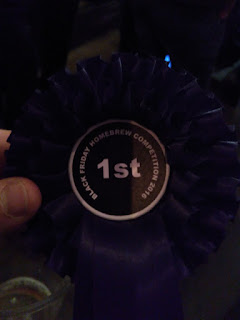 |
| The winning black rosette |
A black hefeweisse, well if that sounds a bit odd, it is. Its not really a style, but the aim of the Black Friday competition is to make any type of beer you like as long as it is black. One of the best beers i tried at the 2015 competition was a black hefe so i thought I'd have a go at making my own.
My approach was to make a standard hefewiesse bier but with some roasted wheat malt (which has a very mild roasted malt flavour) to add the requisite blackness.
The beer didn't win the whole competition. But it did win it's flight. The flights are the subcatagories in the competition (eg Stout, Porter, Mild). My beer was put in the experimental beer flight, which was fair enough as the beer doesn't really fit in any of the existing styles.
When they announced the results I was completely surprised. But the judges loved the beer. They said it had a lovely big banana and clove aroma - BOOM that's the classic hefeweisse aroma! I think the key thing I did was to carry out a feurlic acid rest during the mash, which is supposed to really accentuate the clove/banana aroma. Worked a treat!
Black Hefeweisse 4.1%
11L Brew in a bag mash
Feurlic Acid rest at 45C for 20 mins
Mash at 67C for 60mins
Grain:
2.67kg Pale wheat malt
0.23kg
Hops:
4.5g Pheonix @FWH 60minutes (used this because it has a bit of a chocolate taste)
9g Pheonix @30 mins
4.5g Pheonix @FO
OG1051
FG1020









































